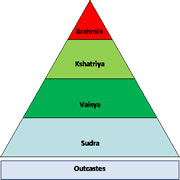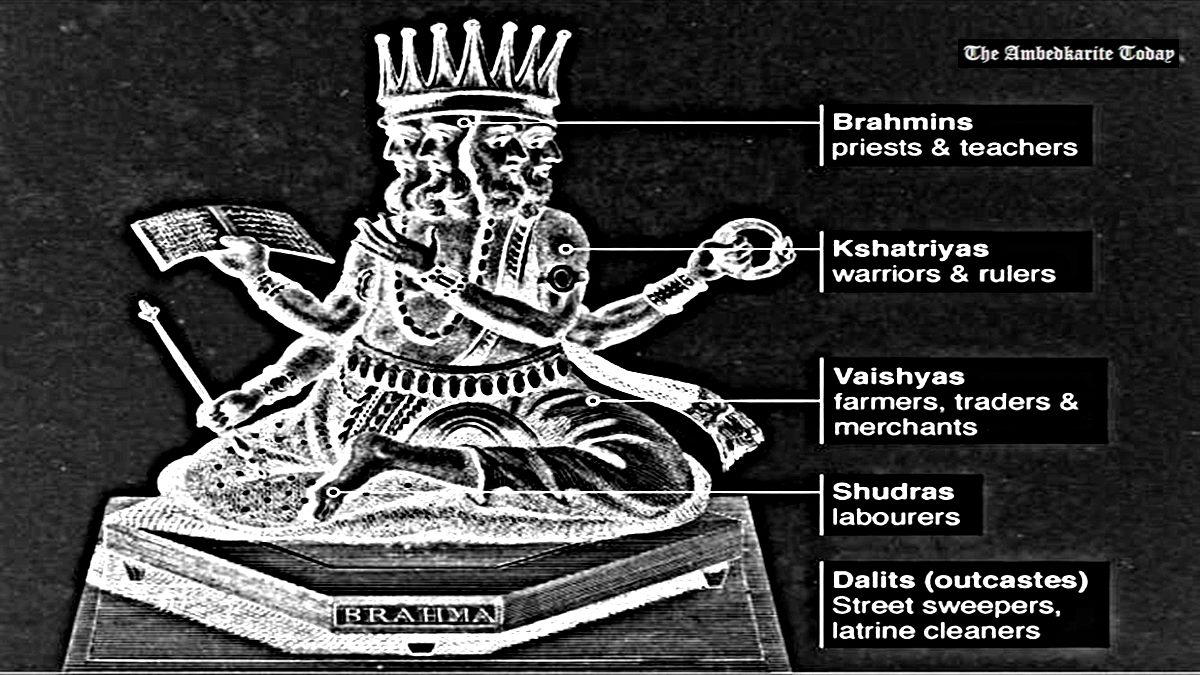There are different theories regarding the origin of the caste system in India. The religious theory claims that the Varnas were created from the body of the Brahma, the creator of the world. The Brahmanas were created from his naval; the Kshatriyas from his hands; the Vaishyas from his thighs and the Sudras from his feet.
The word “Caste” itself stems from the Spanish and Portuguese “casta”, which means “race, lineage, or breed”.
It was applied by white colonials during the 17th century C.E. to refer to the system of social codification they witnessed existing in South Asia.

The native terms for Caste are often “varna (Caste group)” and “jati (Caste)”. Each Caste group encompasses within it several individual Castes varying in cultural and social practices, and who are limited from structural power by their placement within the pyramid.
According to the social historical theory, the origin of caste system finds its origin in the arrival of Aryans in India. The Aryans arrived in India in around 1500 BC. The Aryans disregarded the local cultures. They began conquering and taking control over regions in north India and at the same time pushed the local people southwards or towards the jungles and mountains in north India.
The Aryans organised themselves in three groups. The first group was of the warriors and they were called Rajanya, later they changed its name to Kshatriyas. The second group was of the priests and they were called Brahmanas. These two groups struggled politically for the leadership among the Aryans. In this struggle the Brahmanas emerged victorious. The third group was of the farmers and craftsmen and they were called Vaisyas. The Aryans who conquered and took control over parts of north India subdued the locals and made them their servants.
Between the outcasts and the three Aryan Varnas there is the Sudra Varna who are the simple workers of the society. The Sudras consisted of two communities. One was of the locals who were subdued by the Aryans and the other was the descendant of Aryans with locals.
In Hindu religious stories there are many wars between the good Aryans and the dark skinned demons and devils. The different Gods also have dark skinned slaves. There are stories of demon women trying to seduce good Aryan men in deceptive ways. There were also marriages between Aryan heroes and demon women. Many believe that these incidents really occurred in which, the Gods and the positive heroes were people of Aryan origin. And the demons, the devils and the dark skinned slaves were in fact the original residence of India whom the Aryans coined as monsters, devil, demons and slaves.
Like most societies of the world, in India also the son inherited his father’s profession. And so there developed families, who professed the same family profession for generation in which, the son continued his father’s profession. Later on as these families became larger, they were seen as communities or Jatis. Different families who professed the same profession developed social relations between them and organised as a common community, meaning Jati.
Later on the Aryans who created the caste system, added to their system non-Aryans. Different Jatis who professed different professions were integrated in different Varnas according to their profession. Other foreign invaders, who conquered parts of India and created kingdoms, were integrated in the Kshatriya Varna (warrior castes). But probably the Aryan policy was not to integrate original Indian communities within them and therefore many aristocratic and warrior communities that were in India before the Aryans did not get the Kshatriya status.
Castes In India
Caste apartheid is the system of religiously codified exclusion that was established in Hindu scripture. Hindu origin myths state that different people were created from different parts of God Brahma’s body and were to be ranked hierarchically according to ritual status, purity, and occupation. By this system, everyone at birth, is ranked with a Caste. Crucially, Caste is inherited from the family one is born into and is unalterable throughout that person’s life.
There are four main Caste groups. Those at the very top are Brahmins, who have traditionally been priests, scriptural knowledge-keepers and legislators. Below them in status are the Kshatriyas, who were kings and warriors. They are followed by Vaishyas, or the merchant classes. People in these three Caste groups are often referred to as the “upper” Castes. Those at the bottom of the Caste hierarchy are Shudras or traditional peasants. Many Shudras are also termed “Oppressed Castes”. Outside the 4-Caste group structure are people considered lower than the lowest of Castes.
They go by the term Dalit (meaning “broken” but “resilient”), formerly known as “untouchables” and the Adivasis, or the indigenous peoples of South Asia. Together these Caste-oppressed groups continue to experience profound injustices including socioeconomic inequalities, usurpation of their land, rights, and brutal violence.
The Caste one belongs to can determine your perceived level of ritual purity or pollution and goes on to determine the outcomes of your whole life – from where one can live and die, to what one can eat, what one’s occupation can be, and even who one can marry. The “Untouchables” in particular, are embroiled in a system of Caste apartheid even today. Their experience is made up of segregated ghettos, banned from places of worship, and denied access to schools and other public amenities including water and roads.
This entire system is enforced by violence and maintained by one of the oldest, most persistent cultures of impunity throughout South Asia, most notably in India, where despite the contemporary illegality of the system, it has persisted and thrived for 2,500 years.

